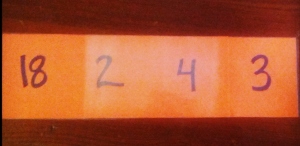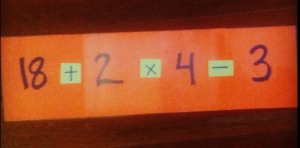Order of Operations Activity
29August 10, 2012 by ray_emily
 Last week for #MyFavFriday, I wrote about a totally silly non-academic game. This week, I want to share a game that I like lots, which actually has some academic substance. I’m honestly not sure if I thought up this activity on my own, or stole it from someone along the way. I am tempted to say that I devised this activity, myself, but … who knows. (Please do let me know if it’s yours.) Also: Apologies, in advance, for the terrible photo quality. Going to need to work on that, I suppose. Hopefully you get the idea, anyway.
Last week for #MyFavFriday, I wrote about a totally silly non-academic game. This week, I want to share a game that I like lots, which actually has some academic substance. I’m honestly not sure if I thought up this activity on my own, or stole it from someone along the way. I am tempted to say that I devised this activity, myself, but … who knows. (Please do let me know if it’s yours.) Also: Apologies, in advance, for the terrible photo quality. Going to need to work on that, I suppose. Hopefully you get the idea, anyway.
And, without further ado, THE ORDER OF OPERATIONS GAME!
The set-up:
My classroom has five tables, each of which seats five kids. I pass one laminated strip, like so, to each table. (All of the strips are exactly identical.)
Each table also gets an envelope with the following pieces:
[Update, 8/27/12: The one and only @jreulbach created a characteristically well-designed version of the game pieces that you see above. Check them out (download either the Word doc or PDF) and steal them! Now you’re set!]
How it works:
You start the game by calling out a number. (You will need to plan which numbers to call out — or feel free to use mine.)
So, let’s say you shout out, “77!”
Kids immediately start scurrying and scratchworking and talking and debating. (Their goal, if you hadn’t gathered, is to correctly place the operational symbols, and maybe some exponents, on the strip so that the numbers equal 77.) There is a frenetic, excited energy in the room: three points will go to the first team to get to 77! Second place earns your team two points, and third place gets you one point.
I weave around the room and eavesdrop.
Kid #1: “Let’s put the plus sign there!”
Kid #2: “Okay! So now we’re at 20. What next?”
Kid #1: “Umm…. we could… subtract?”
Kid #3: “Oooh, I know. Multiply by four–”
Kid #4: “Yeah, yeah! Multiply by four, then get rid of the three, and…”
Kid #5: “Yes, we got it!!! OOOOH, ooh, pleasepleeeeaasecomecheckours!” (Hands wave wildly.)
They beam, proudly looking over their work as I head in their direction.
Suddenly–
Kid #5: “No… WAIT! Not yet!”
I shrug and head to another table. They join heads.
Kid #5: “We need to make it so the adding happens before we multiply,” I overhear.
Kid #1 eagerly retrieves the parentheses, and Kid #2 positions them around 18 + 2.
And, the hands go shooting into the air, for a second time. All around, groups of students are sharing similar exchanges—working together, working backwards, guessing and checking, arguing, persevering.
After a few minutes, the three winners have been established. I then write “18 2 4 3” on the board, and call up a student to fill in the holes. We talk about the wrong answers that they produced, and analyze what exactly caused the derailments. Error analysis melds with strategizing to do better next time melds with collaboration melds with total awesomeness.
… and then, we do it again!
Other stray thoughts and suggestions:
– “Let’s put the plus sign there,” and other similarly low-risk suggestions, offer a non-intimidating way for less confident kiddos to get involved. Finding a point of entry is simple (there are so many possibilities!), which means that this activity is welcoming to students of all ability levels.
– Make sure your kids know that as soon as you award them their points, they need to quickly remove the operational symbols that they’ve laid down. (Other teams will look; they won’t be able to resist.)
– If you have a class of eager beavers—kids so desperate to earn their points that they fail to stop and think and double-check—you can dock one point for a wrong answer, or require that everyone work for a minimum amount of time before summoning you.
– It amuses me, a little, that the kids get all worked up. I do not offer any sort of prize, but I think the competitive element spices things up a little bit. (It is probably not necessary, though, to tell the truth.)
– Encourage your kids to keep out a paper and pencil to test out their possible solutions. (An added bonus, which students generally fail to discover, is that occasionally, the wrong solution from early in the game is in fact a winning solution, later on.)
– There are many opportunities for easy differentiation. If I’ve got a group of kids that is not totally solid on applying the order of operations, I will tell them which three of the four operational symbols are needed for each problem. They still, of course, need to determine the correct order. If kids are getting it and digging the activity, I will not tell them which symbols to use. This increases the level of difficulty considerably.
– I start out with problems that do not require parentheses and exponents, and work my way to those that do, depending on kids’ success rates.
P.S. I am decidedly not crafty. For several years running, my kids received raggedy sheets of legal paper (with the numbers on them) and little pieces of chopped up note card (with the symbols) in wrinkly, worn-out plastic bags, when it was time to play this game. My desire to share this activity here compelled me, at last, to laminate those suckers. (I had to make a new set, of course. Mine had taken a beating.) I’m going to attempt be better about that, this year. (Something to add to my list of goals, I suppose.) I’ve developed enough games that I want to have on hand, that aren’t dingy and depressing and shame-inducing, that I think it’s time for me to step it up.




Great idea, Rachel! These kind of “play” activities are so helpful in getting kids to better understand and remember the order of operations. This could totally be a nice start of the year activity to get the kids used to working in groups.
I love it!!! This reminds me a bit of the game “24”, which I plan to use a lot as warmups this year – those mental math skills and Order of Ops are something that all kids can work on, regardless of level.
I can’t wait to try this out with my Algebra 2 students. Order of Operations is one of the first things we review, and I think this will be a fun way to do it. Plus, I just got a laminator. So excited to do this!
I love, love, love this and am totally stealing ASAP! I really need to find out if my school has a laminator! Great job!
I can’t wait to use this! I’ve played 24 with my students before, but I really love that they have to physically put the signs in! Thanks for sharing!
To lzlomek and druinok:
Hm. The teacher who taught in my classroom before I came along left behind the game 24, but I’ve let it sit and collect dust. (Sad.) I’ve heard that it’s great – and I can obviously read the directions, myself (!) – but I think someone should write up a blog post about how they use 24 in their class, how it benefits kids, and why kids dig it. Any takers?
I love it and know my students would to!
Great activity idea, and I love that the kids have all of the separate operation symbols! (I can so hear those students’ conversations in your class, too.)
Besides 24, another great way to keep those Order of Operations skills sharp all year is Krypto, which uses cards with values from 1-24. It’s a little bit more challenging because you start with 5 numbers, not 4, and the “target number” changes every time. I use it as a warm-up. Students who quickly find one solution can be challenged to find more, then we share a few solutions and allow other students to correct any Order of Operations mistakes that have been made (sometimes their calculations are correct but the notation is not) .
I had a lot of fun creating this for my Algebra class. I decided to slowly add in additional cards (students started with just the four operations and after a few problems I added in the set of parentheses and worked up to exponents). What a great idea and they really enjoyed it – what a wonderful way to challenge the students and make them think on the first day!
LOVE the idea of using this as a first-day activity. So glad to hear that it went well!
I just made the whole set and am trying it out either tomorrow or next week. I made it in a word doc if you want it. Just email me. :)
Hey! How did it go – ?!
I would love a copy…
Can I get your word doc. On the order of operations activity from 2012
Everything is linked to in the blog post, I think? What exactly do you need?
I would love a copy!
[…] tomorrow we will do some problems on white boards and also play this game. I am so excited for the game because I have been hearing about it going really well from twitter […]
[…] read about this amazing game over on Writing to Learn to Teach this summer. It looked awesome so I made my own set for each […]
By the way, a comment from a student on my classroom blog after we played this game “This game was awesome! So fun!” :)
MY STUDENTS BOMB THEIR ORDER OF OPERATION QUIZ. I AM GOING TO TRY THIS TODAY
This is so great! Thank you for sharing! Looking forward to trying it tomorrow!
[…] Order of Operations Activity. […]
Thank you for the activity. It was great to challenge my students and hear the conversation that was happening between each group.
Thanks! Glad you enjoyed it.
Thank you for sharing, love your idea and I know my kids will have lots of fun while learning the objective. Please if you have any other ideas or good questions for this TEK please share
[…] found this game on Pinterest and I absolutely love it for practicing order of operations. The kids absolutely love […]
Great idea. I’m now pondering how I could use this with variables!
Thank you so much for this activity! I used it this past summer in my summer school class as well as a review at the beginning of the year for my 8th graders. They loved it! I love how it is so easy for the teachers to cater to their students’ abilities and levels. Such a great idea!